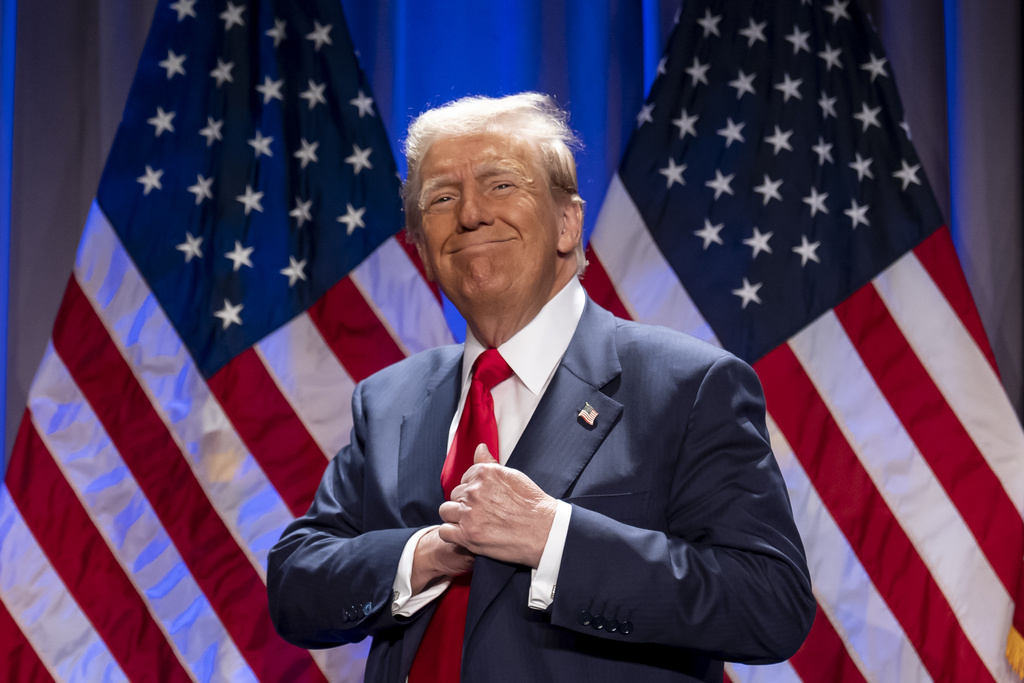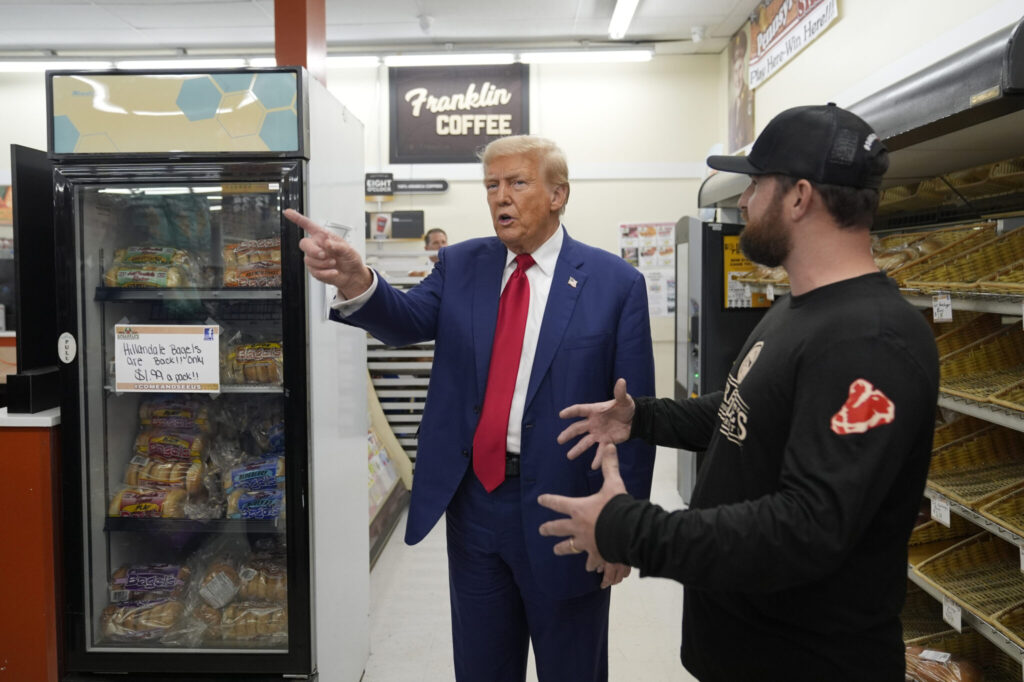Food prices/ grocery inflation/ Trump tariffs/ immigration/ U.S. economy/ grocery costs/ food production/ Newslooks/ WASHINGTON/ J. Mansour/ Morning Edition/ While President-elect Donald Trump vowed to reduce food prices, experts suggest his proposed tariffs and immigration policies could increase grocery costs. Although voters are concerned about high prices, economists say Trump’s strategies may not address the deeper, complex causes of food inflation.

Trump’s Food Price Plans Quick Looks
- Food Prices on the Rise: U.S. grocery prices surged 28% since 2019, worrying most voters.
- Trump’s Promise: Trump pledged to lower costs through tariffs on imports and deportation of undocumented workers.
- Tariffs’ Impact: Experts warn that tariffs could make imported food and farm supplies pricier, raising costs for consumers.
- Labor Concerns: Economists predict deporting undocumented workers would strain the food sector, driving up prices.
- Energy Costs: Trump claims that boosting oil and gas production will lower food prices, though energy only slightly impacts grocery costs.
- Economic Experts Weigh In: Economists doubt the short-term efficacy of Trump’s approach, noting the complexity of food inflation drivers.
- Voter Sentiment: Despite expert skepticism, many voters support Trump, hoping his policies will ease the burden of grocery bills.
Experts Doubt Trump’s Strategy Will Lower U.S. Grocery Costs
Deep Look
Food prices in the U.S. have become a pressing concern for consumers, with many hoping President-elect Donald Trump can ease grocery costs. During his campaign, Trump targeted food price inflation, promising to “get them down” through tariffs on imported goods and a crackdown on undocumented labor. However, experts believe these approaches could backfire, potentially pushing prices even higher.
U.S. grocery prices have climbed significantly, rising 28% since 2019, and while growth slowed in 2024 to a 2% increase, sticker shock remains strong. According to AP VoteCast, around 70% of voters are highly concerned about food prices, with Trump securing the support of nearly 60% of voters who identified as “very concerned” about grocery costs. This widespread worry has driven demand for solutions, but economists suggest Trump’s strategy may not be the answer.
Tariffs and Imported Food Prices
In a September town hall in Michigan, Trump advocated for higher tariffs to bolster U.S. agriculture, proposing a 60% tariff on Chinese goods and a 10% to 20% universal tariff on all other imports. Trump argued that U.S. farmers were “decimated” by foreign imports, and his approach would reduce competition, allowing American farmers to thrive.
However, David Ortega, a food economics professor at Michigan State University, cautions that tariffs could make key imports like fertilizer, machinery, and packaging more expensive. These costs could trickle down to consumers as grocery prices climb. Additionally, other countries might retaliate with tariffs on American agricultural exports, creating challenges for U.S. farmers, 20% of whose products are sold overseas.
Labor Challenges and Deportation Impact
In addition to tariffs, Trump’s plan to deport undocumented workers could impact the food sector. Over 2 million undocumented workers are employed across the U.S. food supply chain, with roughly 1 million in agriculture, 750,000 in restaurants, and 200,000 in food production. Ortega warns that deporting these workers would shrink the available labor pool, driving up wages and potentially causing higher prices at the checkout counter.
The Consumer Brands Association, representing major food companies, voiced concerns that tariffs could affect essential imports such as coffee, chocolate, and bananas, leading to greater costs for companies and consumers alike. Tom Madrecki, the group’s vice president, noted that “there is a fundamental disconnect” between Trump’s aim to reduce prices and policies that could, instead, raise costs for everyday items.
Energy Prices and Food Production
Trump has also promised to reduce energy costs by ramping up oil and gas production, asserting that lowering energy bills will reduce production costs across industries, including food. At the Michigan town hall, Trump claimed he could reduce energy bills by 50% within a year. While energy is a component of food costs, it accounts for less than 4 cents of every dollar spent on food. By comparison, labor, transportation, and packaging costs play more substantial roles in overall pricing.
Joseph Glauber, a senior researcher at the International Food Policy Research Institute, expressed doubt that Trump’s energy plans would affect food prices in the short term, especially as energy costs have already decreased from earlier spikes.
Complex Causes of Food Inflation
Trump’s approach also overlooks the global and multifaceted factors behind recent food inflation. High grocery prices began rising sharply in 2021 due to COVID-19 disruptions, worsened by the war in Ukraine, which impacted grain supplies and fuel costs. Natural disasters, such as avian flu, also limited supply, particularly in poultry and egg markets.
Economists stress that inflation driven by such complex factors cannot easily be reversed, especially by tariffs or deportations. Maria Kalaitzandonakes, an agricultural economist from the University of Illinois, highlighted that while presidents have limited power to control grocery prices directly, they can advocate for policies that address inflation in the long run, such as investments in agricultural infrastructure and technology.
Voter Sentiments and Trust in Leadership
Despite the complex economic backdrop, many voters still believe politicians can effectively reduce food prices. According to the Gardner Food and Agricultural Policy Survey, 74% of Republicans and 62% of Democrats think their parties can reduce grocery costs. For some, Trump’s business experience is reassuring. Jordan Voigt, a single parent from North Carolina, believes Trump can “stand up” to price increases, helping to relieve the burden on everyday Americans.
However, experts argue that sustained price declines typically only occur in severe recessions, with lasting deflation unlikely. Economist Ortega noted, “People want grocery prices to get down to pre-COVID levels, and that’s just not going to happen.” He emphasized that the focus should be on income growth to match inflation, rather than expecting food prices to fall drastically.
Kalaitzandonakes echoed this, suggesting that instead of prioritizing price cuts, the government should consider policies that help incomes rise in line with inflation. Addressing food inflation requires a holistic approach, involving global supply chain stability, domestic agricultural investment, and innovation in food production.
In summary, while Trump’s proposed tariffs and labor policies reflect his promise to control costs, economists believe they may have the opposite effect. The interconnected nature of global supply chains, reliance on international goods, and labor dynamics mean that U.S. food prices are likely to remain resistant to quick fixes. Voters looking to Trump for grocery relief may find that broader economic forces pose challenges too complex to overcome solely with tariffs and immigration changes.







